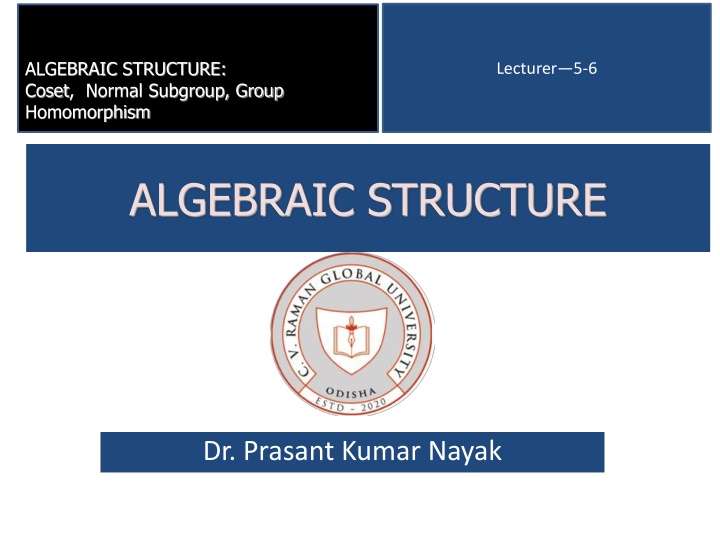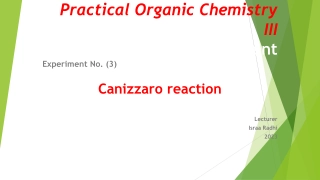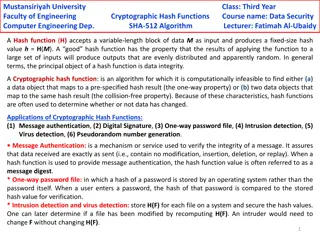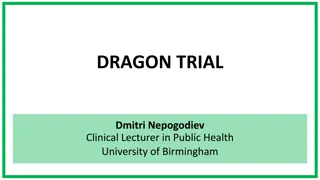
Algebraic Structure: Coset, Normal Subgroup, Group Homomorphism Lecture by Dr. Prasant Kumar Nayak
Explore the concept of cosets, normal subgroups, and group homomorphisms in the algebraic structure. Understand the properties and applications of cosets, including examples and proofs related to Lagrange's Theorem. Dive into the fascinating world of abstract algebra with Dr. Prasant Kumar Nayak's lecture.
Download Presentation

Please find below an Image/Link to download the presentation.
The content on the website is provided AS IS for your information and personal use only. It may not be sold, licensed, or shared on other websites without obtaining consent from the author. If you encounter any issues during the download, it is possible that the publisher has removed the file from their server.
You are allowed to download the files provided on this website for personal or commercial use, subject to the condition that they are used lawfully. All files are the property of their respective owners.
The content on the website is provided AS IS for your information and personal use only. It may not be sold, licensed, or shared on other websites without obtaining consent from the author.
E N D
Presentation Transcript
ALGEBRAIC STRUCTURE: Coset, Normal Subgroup, Group Homomorphism Lecturer 5-6 ALGEBRAIC STRUCTURE Dr. Prasant Kumar Nayak
Coset let H be a subgroup of a group G , then left coset aH= ? :? ? ??? ? Similarly right coset Ha= ?:? ? ??? ? Example: if binary operation is addition then ? + ? = + ?: ? ? + ? = ? + : ?
Coset Example: let G be additive group of integers ,that is G= . 3, 2, 1,0,1,2,3 Let H be the subgroup of obtained G on multiplying each element of G by 3. then H= .. 9, 6, 3,0,3,6,9 Then right coset of H in G are H+0= 9, 6, 3,0,3,6,9 .. H+1= 8, 5, 2,1,4,7,10 . H+2= 7, 4, 1,2,5,8,11, .. We see the right cosets ? + 0,? + 1,? + 2 are all distinct and disjoint
Coset What about H+3,H+4,H+5 .. Note: In abelian group each left coset equal to right coset.
Properties of cosets: (Home work) Proof the following Let H be a subgroup of G, and a,b belong to G then, 1. ? ?? 2. aH=H if and only if ? ? 3. aH=bH or ?? ?? = Or Let ?? and ?? be two cosets of H. either ?? and bH are disjoint or they are identical. 4. ?? = ?? if and only if ? 1? ?
Lagrange's Theorem If G is finite group and H is a subgroup of G, then |H| divides |G|. The number of distinct left (right) cosets of H in G is |G|/|H|
Proof: Let H G with |G| = n, and |H| = k. Write the elements of H in row 1: e h2 h3 hk
Proof: Choose any a2 in G not in row 1. Write a2H in the second row. e h2 h3 hk a2 a2 h2 a2 h3 a2 hk
Proof: Continue in a similar manner Since G is finite, this process will end e a2 h2 h3 hk a2 h2 a2 h3 a2 hk a3 : ar a3 h2 : ar h2 a3 h3 : ar h3 a3 hk : ar hk
Proof: Rows are disjoint by Each row has k elements by e a2 a3 : ar h2 h3 hk a2 h2 a3 h2 : ar h2 a2 h3 a3 h3 : ar h3 a2 hk a3 hk : ar hk
My proof: Let r be the number of distinct cosets. Clearly |G| = |H| r, and r = |G|/|H|. e a2 a3 : ar h2 h3 hk a2 h2 a3 h2 : ar h2 a2 h3 a3 h3 : ar h3 a2 hk a3 hk : ar hk
Normal subgroups Definition 18 normal subgroup if gH=Hg for g G. Example: Any subgroups of Abelian group are normal subgroups. A subgroup H of a group is a
Normal subgroups Theorem: A subgroup H of a group G is normal if and only if ? ??? ? for every ? ? ,? ?. Proof: Let H be a normal subgroup of a group G for every ? ? ,? ?. Then ?? = ?? (by definition ) Now ?? ?? = ??
Normal subgroups SO ?? = ??? ??? ???? ?? ? That is ? ??? = ?? ? Conversely ? ??? ? ??? ????? ? ? have to show that ?? = ?? i.e ?? ?? ??? ?? ?? we
Normal subgroups Consider ? ? for any ? ?, ? ??? ? ?? = ? ? ??? ?? = ??? ?? ?? ?? Similarly ?? = ??? ?? ?? ?? ?? Hence ?? = ??
Homomorphism of Group Let ?,. ??? ?, ?? ??? groups and ? be function from ? into ?. Then ? is called a homomorphism of ? into ? if for all ?,? ? ? ?.? = ? ? ?(?) A Homomorphism ? of a group ? into a group ?? is called a isomorphism of G onto ?? if ? is one-one and onto.
Homomorphism of Group Example: Let G=R be the group of real number under addition ?+,??? ????? ?? ???????? ???? for multiplication. The mapping ?:? ??given by ? ? = ?? is a group homomorphism because ? ? + ? = ??+?= ??.??= ? ? .?(?) ??= and numbers





















